








































Carviva Technologies, an indigenous tech solution provider in Nigeria, has introduced financing options in its bid to make car ownership more affordable and sustainable for Nigerians.

Towards this end, the tech firm says it has structured its payment plans to make them flexible to ensure easy accessibility as much as possible for car owners. “By providing flexible payments, lower markups, and lowinterest rates, Carviva is looking to make car ownership more affordable and sustainable for car owners to maintain their cars in a cost-effective manner,’’ its co-founder and chief commercial officer; Adebola Desalu said.
“We at Carviva understand the current global economic conditions and have partnered with a few
financial institutions to enable financing options for car spare parts, lubricants, long-term car servicing plans, and other accessories.
“We believe this will encourage car owners to purchase original items and pay at their convenience. Payments are spread over three to six months with minimal interest and markups on the products. Our goal is to promote car ownership sustainability and make sure Nigerian drivers get the best out of their cars for the long term.”
Carviva, according to him, is committed to ensuring the safety and security of its users with an experience large enough to allow payers to be confident when making payments. “This financing option is an exciting development for car
owners in Nigeria, giving them more control over the value of their vehicles and increasing the chances of a higher return on investment,’’ he further explained.
The financing option is not a new concept as it is a common practice across the world that has affected car users positively. Carviva believes this option will have the same effect on car owners in Nigeria as it will afford them the opportunity to budget accordingly.

Stellantis invest in Africar Group to create Auto24, a new subsidiary of Africar Group, launches its activities in Ivory Coast. Africar Group is a class leading and multi country digital automotive marketplace across SubSaharan Africa. Stellantis investment aims at accelerating its used vehicle (UV) business on the buoyant African UV market. Auto24 is a faster and safer way to buy and sell used vehicles in Africa.
With the African population set to reach 1.7 billion by 2030 and a car-park already at 50 million units, Stellantis has taken a stake in Africar Group to create Auto24 and take advantage of this market potential. This investment is a new building block in the global strategy of Stellantis to develop its mobility solution portfolio and reinforce its commitment to customer centricity.
Operating in more than 40 countries in Sub-Saharan Africa, Africar Group is Africa’s leading online automotive marketplace network. During the last five years, it has enabled over 25 million car buyers and sellers to trade used cars through its online channels. Axel PEYRIERE, co-Founder & CEO of Africar Group said, “After more than five years of working with automotive manufacturers,
distributors and other key players in the industry, we have developed a class leading, multi country digital automotive solution across SubSaharan Africa. Auto24 is being launched today with the aim to buttress the confidence of African customers in the used vehicle market. A great challenge that will allow to have a secure, convenient, trustworthy and enjoyable buying or selling used vehicle experience.”

Coscharis Motors has signed a memorandum of understanding (MoU) with AIICO Insurance Plc and Tangerine Life to integrate insurance into its automobile sales across its showrooms in the country.

In the insurance industry, there are concerns that the level of insurance penetration and awareness is still at the lowest level. Collaboration in the automobile sector is expected to increase the well-being of the sector.
The General Manager of Marketing and Corporate Communications, Coscharis Group Abiona Babarinde, speaking at the joint venture event held in Lagos, said the partnership was conceived to promote costeffective premium insurance for brand-new vehicles purchased from the automobile company. Babarinde said the partnership would also
allow its customers to insure their vehicles at a premium rate of 1.7 per cent of the value of the car.
“As a result, existing and prospective customers of Coscharis will continue to enjoy premium automobile aftersales service. From this partnership, customers and prospects of Coscharis, Tangerine, and AIICO brands stand to gain significantly with well-thought-out procedures to speed up the claims process.
“They will also enjoy a seamless
customer experience, which includes priority attention for necessary repairs or replacements,” he said.
The Head of Partnership and Alliance, AIICO, Piyush Srivastava, expressed happiness about the partnership with Cosharis Motors. The partnership aims at delivering more value to automobile customers by improving their overall ownership experience, he said.
“Coscharis Motors’ customers will enjoy the same ‘no-stories,’ excellent after-sales service with an insurance cover that meets their needs without drama regarding claims.
“This seamless experience in car ownership makes this partnership truly exciting for prospective car owners to choose one of the mobility solutions from Coscharis Motors,” he said.
Motor vehicle distributor, CFAO Motors Kenya has opened a central parts outlet for its Winpart division, as it seeks to expand product offering and services by distributing original vehicle maintenance spare parts.
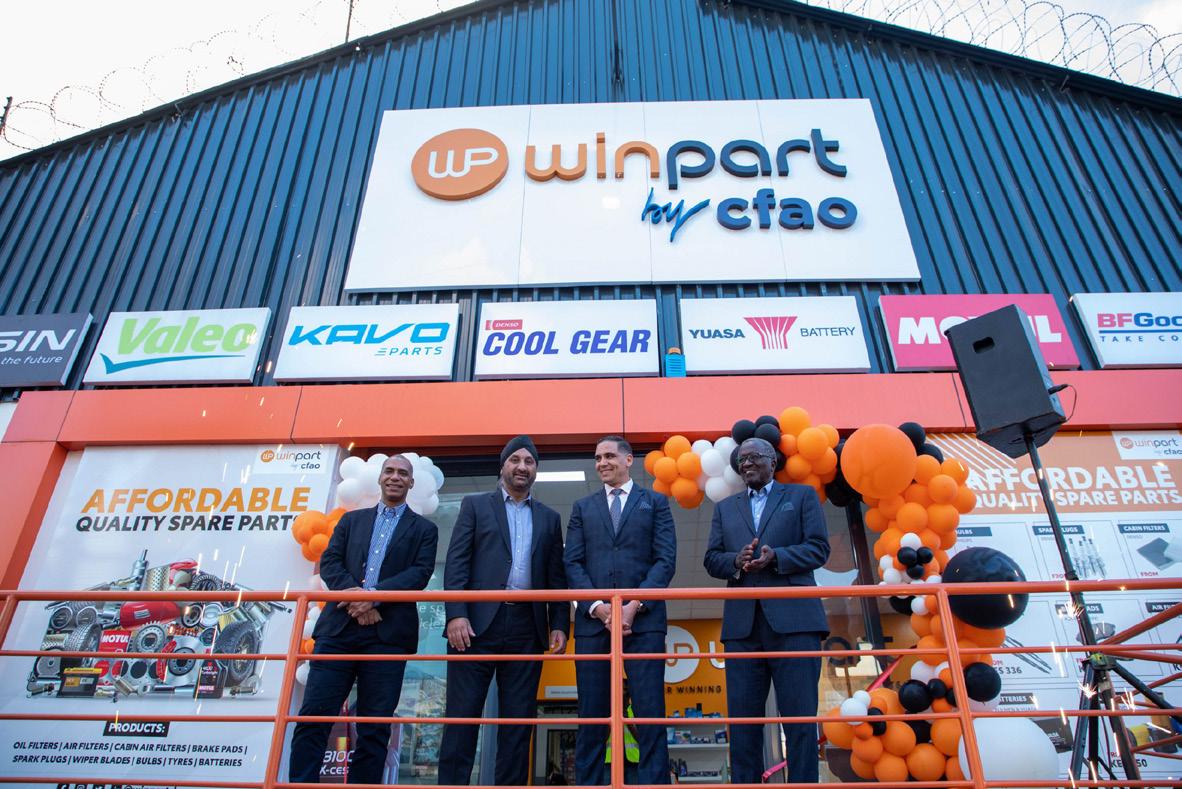
Speaking at the opening of the outlet, CFAO Motors Kenya Managing Director Arvinder Reel said the decision to expand comes at a time when the demand for affordable quality spare parts is on the rise.
“This outlet enables us to meet the diverse demands and customer needs by providing premium independent aftermarket products from power brands such as Denso, Motul, and Aisin GS Yuasa to name a few,” said Reel.
Winpart is a one-stop-shop and distributor of maintenance spare parts with a competitively priced
range of automotive parts from Original Equipment Manufacturers (OEMs).

Reel noted that approximately 80 per cent of Kenyan motorists drive used cars imported largely from Japan, and CFAO Motors is keen on ensuring that they offer quality, yet affordable parts to maintain and repair these vehicles for enhanced
user experience and to deliver value to the motor industry. Earlier in the year, Toyota Kenya rebranded to CFAO Motors Kenya, as the company moved to become a mobility solutions provider.
CFAO Motors has a strategic focus to serve the B2C consumer segment by offering relevant, quality and affordable solutions.

Nigerian startup Autochek, an auto-tech platform making car ownership more accessible and affordable across Africa, has announced the launch of Autochek Financial Services, a new arm of the business that will focus on providing a range of vehicle financing solutions for consumers and businesses across the continent.

Autochek aims to build digital solutions that will enhance and enable a seamless and safe automotive commerce experience across Africa. The company uses technology to transform the automotive buying and selling experience for African consumers, by creating a single marketplace for consumers’ automotive needs, from sourcing and financing to after sales support and warranties.
Acquisitions have been central to the startup’s speedy expansion strategy. Autochek launched in September 2020 having acquired automotive marketplaces Cheki Nigeria and Cheki Ghana from ROAM Africa. In addition to Ghana, it has expanded to Kenya and Uganda, with the latter two launches having again been accomplished by the acquisition of Cheki properties.
Headquartered in Johannesburg, South Africa, Autochek Financial Services will be led by Johan van der Merwe, a financial services veteran with more than 20 years’ experience in risk, credit and asset finance. Before joining Autochek Financial
Services as CEO, Johan had previous roles as chief risk officer at WesBank Motor, one of South Africa’s leading vehicle and asset finance providers; and SA Taxi, a vertically integrated company that provides financing, insurance and other services for the minibus taxi industry in South Africa.
The Africa head of Ford Motor Co said the South African government must deliver policy certainty on electric vehicles (EVs) within six months to save its automotive industry.
Three quarters of cars produced by South Africa’s auto industry, which accounts for 5% of gross domestic product and more than 100,000 jobs, are exported, mostly to Europe.
But with Britain planning to ban sales of new petrol and diesel cars from 2030 and the European Union in 2035, the local industry risks losing thousands of jobs and billions in revenue in the absence of a government plan for EVs.
“We need policy certainty, literally, within the next six month period,” Neale Hill, President of Ford Motor Company in Africa, told Reuters in an

interview on Friday.
South Africa’s trade and industry ministry said it had previously indicated a policy paper would be out by November 2021 but the deadline could not be met due to “variety of issues”.
“There is a commitment to conclude this matter soon,” it said.
The government issued an Automotive Masterplan in 2018 to help local makers achieve 1% of global production, increase the use of local materials to 60% from 39% and raise employment, among other objectives. It did not include any policy on EVs.
Hill, who is also the President of South African carmakers’ lobby NAAMSA, said auto companies wanted the government to clarify
what parts of the master plan are still up for support.
Ford in March boosted its spending on EVs to $50 billion through 2026 as the Dearborn, Michigan-based company tries to catch up with Germany’s Volkswagen and industry leader Tesla.
“I’m concerned that (the South African) government’s delays and lethargy on this is going to end up costing us having a seat at the table,” he said.
Saudi Arabia-based mobility solutions platform Morni is planning to invest $10 million to target new acquisitions in Egypt in the mobility space through Exists.me, an acquisition and mergers (M&A) advisory firm.
The new buy-side mandate, which will run until 2023, prompts Exits.me to act as Morni’s exclusive advisor, helping them in their expansion strategy and fulfilling their growth objectives, according to a press release.
Launched in 2016, Morni bills itself as a superapp for towing and roadside assistance services. The


startup enables users to obtain integrated logistics services for vehicles in emergency situations. It operates across Saudi Arabia and several GCC cities using a network of over 33,000 service providers.
Morni has been downloaded +2 million times, serving +1.20 million customers. To date, Morni has received funding of $14.7 million and continued to grow its product offering.
Under the newly signed mandate, Exits.me, which is already engaged in a pipeline of sell and buy-side advisory mandates with a tentative
size of $250 million since its launch earlier this year, will be working to help Morni in its expansion strategy across multiple markets in the region within the sector of Road Side Assistance (RSA) & Automotive services.
Egyptian President Abdel Fattah al-Sisi has signed a decree establishing the Supreme Council for the Automotive Industry and a fund for financing the environmentally friendly car industry.
The Council will be headed by the prime minister, and will include the minister of industry as vice president of the council.
The ministers of planning, transport, finance, and military production, and four experts were also nominated by the minister of industry, for a period of four years, as members.
The council aims to develop the automotive industry sector in Egypt.
A fund was established to finance the environmentally friendly car industry, which pertains to vehicles that do not produce emissions or have negative effects on the environment.
The fund aims to develop the necessary resources to finance the environmentally friendly car industry.
Sisi also signed a decree granting some facilities to Egyptian expatriates to import cars.

The facilities include that an Egyptian who has a valid residence abroad has the right to import one private passenger car for his personal use exempt from taxes and fees.
In return for depositing a cash
amount in foreign currency without return at an Egyptian bank.
As a consequence the owner of the car will be exempted of all taxes and fees they had to pay for the import of the car.
The car owner can recover the deposited amount after five years in local currency, at the exchange rate set by the Central Bank of Egypt at the time of retrieval.
Morocco is set to invest €50 million to establish a plant to produce local car brands.
The factory will be made with a 100% Moroccan investment, Morocco’s Minister of Trade and Industry Ryad Mezzour said in a recent interview.
Through the plant, Morocco is set to produce approximately 3,000 cars per year. The number is set to reach 20,000 units within four years.
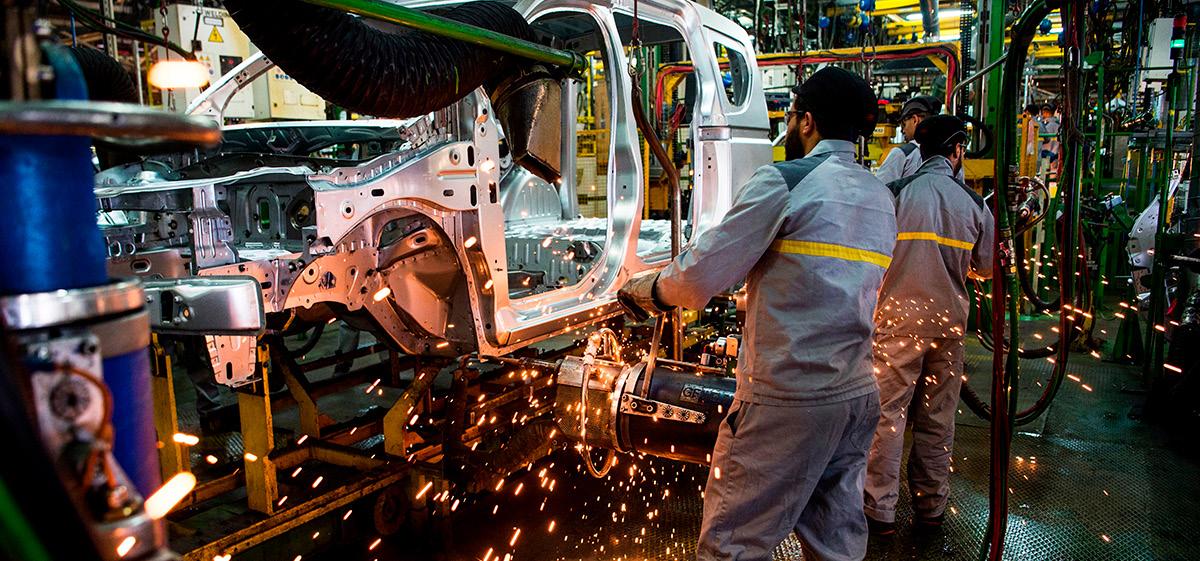
The project is part of Morocco’s approach to boost the automotive sector. The industry has been one of the pillars that contribute to the country’s economy.
Recently, Mezzour said that the
local brand has passed “all the tests successfully.” However, the Moroccan minister rejected to disclose information on the brand’s name.
He stressed that the price of the new car will be offered at competitive prices estimated at $16,200.
According to Mezzour, the milestone project will have a Moroccan name, noting that the ministry of industry
is working alongside Moroccan investors to increase the “integration rate so that the parts are also mainly Moroccan.”
Morocco aims to commercialize the cars in the local market.

“But we are confident and we will support and do the best we can so that this operator has an international dimension,” he said.
Ashok Leyland announced that it has delivered 150 vehicles to the Tanzania Police Force. The units supplied were part of a contract signed with the Ministry of Home Affairs, Tanzania and included buses, 4x4 troop carriers, ambulances, recovery trucks and other logistic vehicles for Police support services.
Speaking on the occasion Amandeep Singh, President, Ashok Leyland said, “It reflects our commitment to support Government of Tanzania and we deeply value our long-standing relation. These 150 vehicles will get added to the 475 Ashok Leyland vehicles which
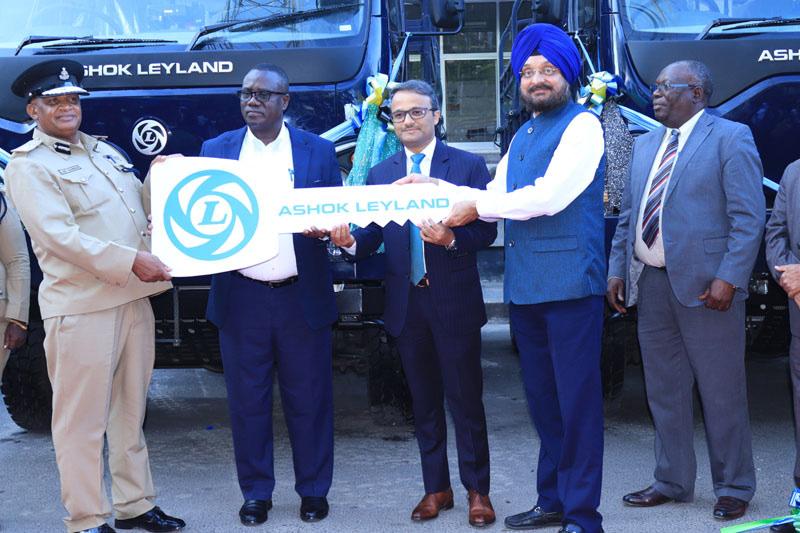
are already in operation with the Tanzanian Police Force across the country”.
The Tanzanian government financed the contract through a long term soft loan taken from the Export Import Bank of India, Government of India. The vehicles were handed over in a ceremony attended by Tanzania Deputy Minister of the Ministry of
Home Affairs, Jumanne Abdallah Sagini, Indian High Commissioner to Tanzania, Binaya S. Pradhan, and Amandeep Singh, President, Ashok Leyland.
The Tanzania Police operate a fleet of 625 vehicles from Ashok Leyland with the company saying more were set to be delivered in the coming months.

South Korean automobile manufacturing companies are planning to set up new assembly plants in Ghana for the production of Korean cars in the country, the Speaker of the Korean
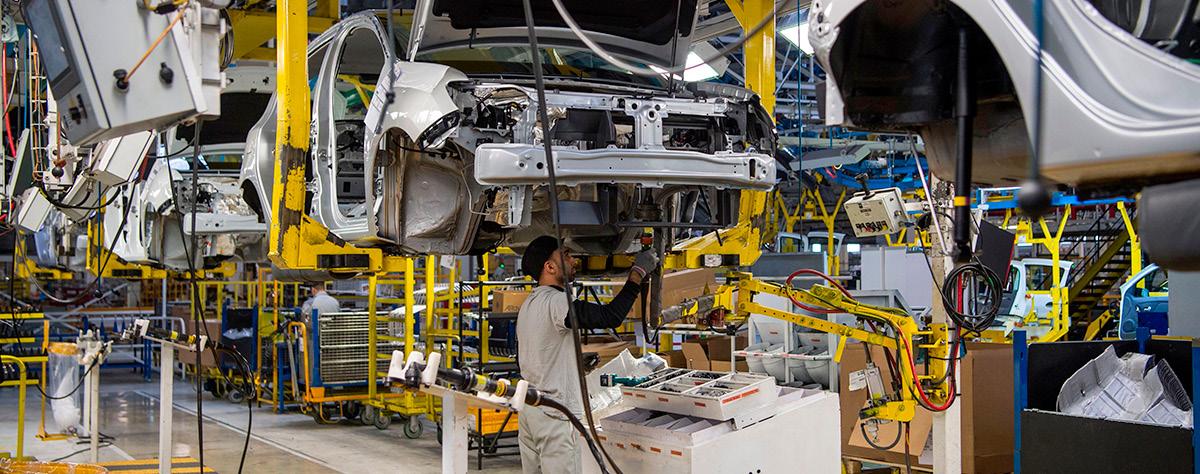
National Assembly, Kim Jin-Pyo, has said.
He said the move was in response to the Ghana government’s automotive development policy aimed at making Ghana a fully integrated and competitive industrial hub for the automotive industry in the sub-region.
In a courtesy call he paid on the Speaker of Parliament, Alban Sumana Kingsford Bagbin, in the Rwandan capital, Kigali, Wednesday (October 13), Mr Jin-Pyo said: “I hope that all goes well with these projects and I would like to ask for your kind support.”
Mr Bagbin (right), presenting a parcel of chocolate gift to Mr Kim Jin-Pyo (left), the Speaker of the National Assebmly of Korea. With them are Mr KyeiMensah-Bonsu (2nd right), the Majority Leader, and Mr Richard Acheampong (3rd right), the Head of Speak | Image courtesy
“I hope that based on what we have achieved in our cooperation, we can continue to encourage Korean
companies to make investments and have bilateral trade with Ghanaian counterparts.
“I also hope Korean and Ghanaian governments would work together more closely to create an environment conducive for more Korean companies to make investments because Korean companies have extensive experience in the fields that serve the interests of Ghana’s economic development,” he said.

The closed-door meeting, which took place on the margins of the ongoing 145th Inter-Parliamentary Union assembly in Kigali, was used to discuss many mutually beneficial issues that bothered on improving bilateral relations, maritime security, expansion of Ghana oil refinery capacity, Ghana-Korean Parliamentary Friendship Group, among others.

Morocco’s state-owned utility company ONEE is set to supply manufacturers in the automotive industry with green energy.
Dubbed the “National Master Plan for Electric Mobility,” the initiative is a step towards Morocco’s aspiration of a carbon-neutral industry. The plan is also set to pave the way for the development of sustainable transport in the Kingdom of Morocco, according to a report from news outlet Afrik21.
The plan will be implemented by 2023, and is the result of cooperation between ONEE, the Institut de la Francophonie pour le Developpement Durable (IFDD), and the Global Sustainable Energy Partnership (GSEP), the report specifies.
Through the initiative, ONEE aims to assess the energy need within the sector in three stages. “The study should lead to proposals for an appropriate regulatory framework and a medium- and long-term reinforcement plan for both electricity production and the distribution network,” ONEE’s Sales and Marketing Director, Elamine Fechtali reportedly said.
The ONEE plan is in line with
Morocco’s transition strategy to electric car (EV) manufacturing. While the country is already Africa’s largest car manufacturer, failing to transition to EV manufacturing could see the country losing its largest customer, the European Union.
The EU is set to ban the imports of cars with combustion engines starting in 2035, giving Morocco a little more than a decade to implement its agenda.
The initiative is in line with Morocco’s strategy to transition into electric car manufacturing and decarbonize the national industry | Image Gettyimages for illustration
The Africa Automotive Show will take place in Abidjan, Cote d’Ivoire as part of the 3rd Intra African Trade Fair (IATF2023) from November 21-27, 2023, the organisers have announced.

As the vision for automotive industrialisation and growth of Africa materialises, the Africa Automotive Show is the ideal platform for all role-players in the automotive value chain to connect from across the continent and globally.
“The aim is for the Africa Automotive Show to be the single most important trade and business development gathering for all automotive role-players, from raw material suppliers, vehicle and component manufacturers, dealers, importers, aftermarket parts manufacturers and suppliers as well as those from the financial and allied industries – from all parts of the continent,’’ says Africa Automotive Show Director Andrew Binning.
Binning said the Africa Automotive Show – hosted by the African Association of Automotive Manufacturers (AAAM) – is a key activity of the cross-sectoral IATF2023 and would include a dedicated automotive exhibition, a highlevel conference and match-making meetings.
“As the event is focussed on trade and partnerships promoting the development of regional automotive value-chains, participants representing all aspects of the automotive value-chain will be attending the week-long event in Cote d’Ivoire next year. ” Binning said.
IATF2023, hosted by the African Export-Import Bank (Afreximbank), in collaboration with the African Union and AfCFTA is anticipated to draw 35 000 visitors from 75 countries and 1600 exhibitors to conclude around $43bn in trade and investment deals.
The African Automotive Show as part of IATF2023 will provide “a unique and valuable platform for businesses

to access an integrated African market of over 1.3 billion people with a GDP of over US$3.5 trillion created under the African Continental Free Trade Area,” Binning said.
Dave Coffey the CEO of AAAM said “Cote d’Ivoire and the West African region provides an excellent and relevant location for this edition of “Africa’s premier automotive show.”
“We believe the Africa Automotive Show is well timed as the automotive industry is gaining traction in Africa where we will see trading of vehicles between assembly hubs across the continent supported by the development of regional value chains. Cote d’Ivoire are currently developing their competitive automotive value proposition that will have profound economic benefits for the country and region in the medium and long term. In collaboration with Ghana and other countries in West Africa that develop their sustainable automotive niche, this will drive scale and real industrialisation”, concluded Coffey.
Exhibition bookings and sponsorship opportunities are available.
Nissan Africa Managing Director Mike Whitfield has hailed the company’s inaugural corporate communications masterclass session as a resounding success. Attended by 25 high level communicators from Nissan dealerships in seven African countries; the key markets of Angola, Ghana, Nigeria, Ethiopia, Kenya, Mozambique and Zimbabwe, the three masterclasses blended cutting edge practical learning with hands on experience of the award winning all new built of more Nissan Navara.
“We have the best people and the best products,” says Whitfield, “but we also have to be the best in telling our story too –both within the company and across the continent.”
Katherine Zachary, Nissan’s regional vice president for communications, agrees. Opening the masterclass from Paris, France, where she is based, she told the delegates that corporate communication was not a ‘nice-to-have’ but a ‘must have’.
“We do more than just tell stories, we analyse other news, we see potential problems and we identify opportunities.”
The masterclass, conceptualised by Nissan Africa’s head of communications Ramy Mohareb and Nthabiseng Motsepe was facilitated by former newspaper editor Kevin Ritchie and former motoring journalist and automotive industry specialist Leo Kok.

“The brief was to cover everything from understanding how newsrooms work and effective communication with the media all the way to crisis management, hosting press releases and preparing executives to be interviewed by journalists, whether in person, in studio or, as is becoming more commonplace, virtually via Zoom,” said Motsepe.
“We achieved what we set out to do and a lot more,”
said Mohareb, “it provided us with the opportunity to get together, to put faces to names after the COVID 19 lockdown, to brush up our skills and also learn more about Nissan.
“We were able to take the Navara off road, understand the cutting-edge Nissan Qashqai and hear from our marketing experts what their plans are for the years ahead as well as receive a top-level briefing on the very exciting Nissan Customer Experience programme that is being rolled out.”

Africa, said Whitfield, comprised 54 very different markets, which was precisely why the company had set up its unique Regional business Unit at the end of 2020 with its dual headquarters in Cairo and Pretoria.
“Telling the Nissan Africa story can’t be effectively done from just one country on the continent any more than it can be done outside the continent. As Africans, we know that if you want to go fast, you go alone, but if you want to go far, you go together. Bringing in our partners from these markets for this pilot project is part of that philosophy.”
MAN Truck & Bus and Van Vliet Automotive Group have introduced the New TG range to the Ghanaian market at a launch event on Friday, 9th December 2022 held at Van Vliet Automotive Ghana Limited, Tema.
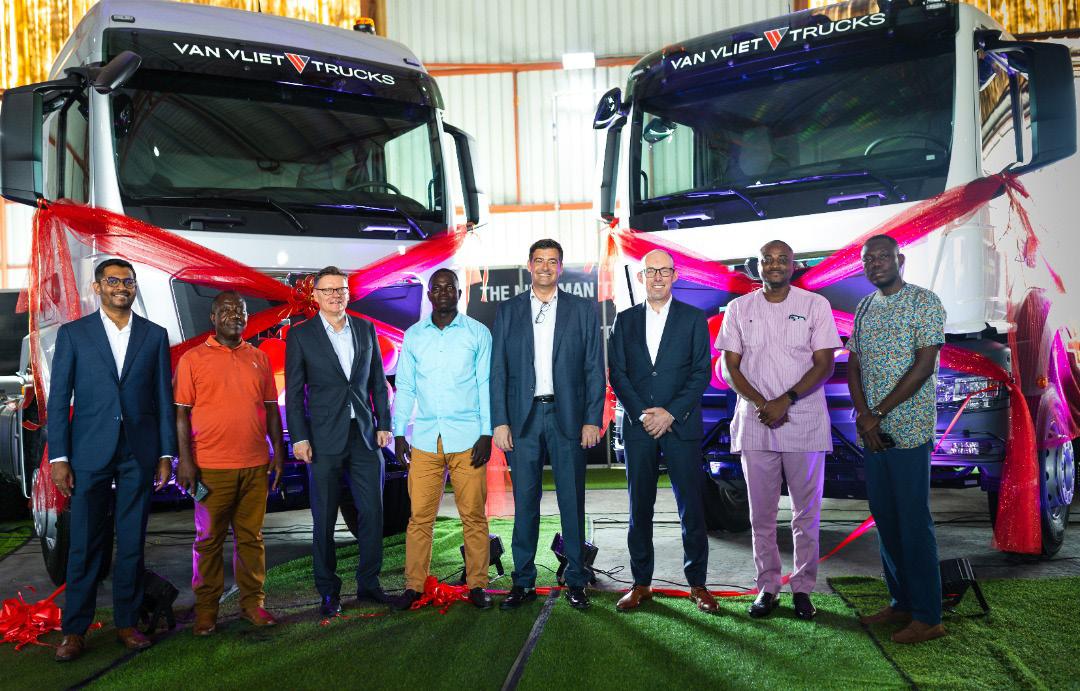
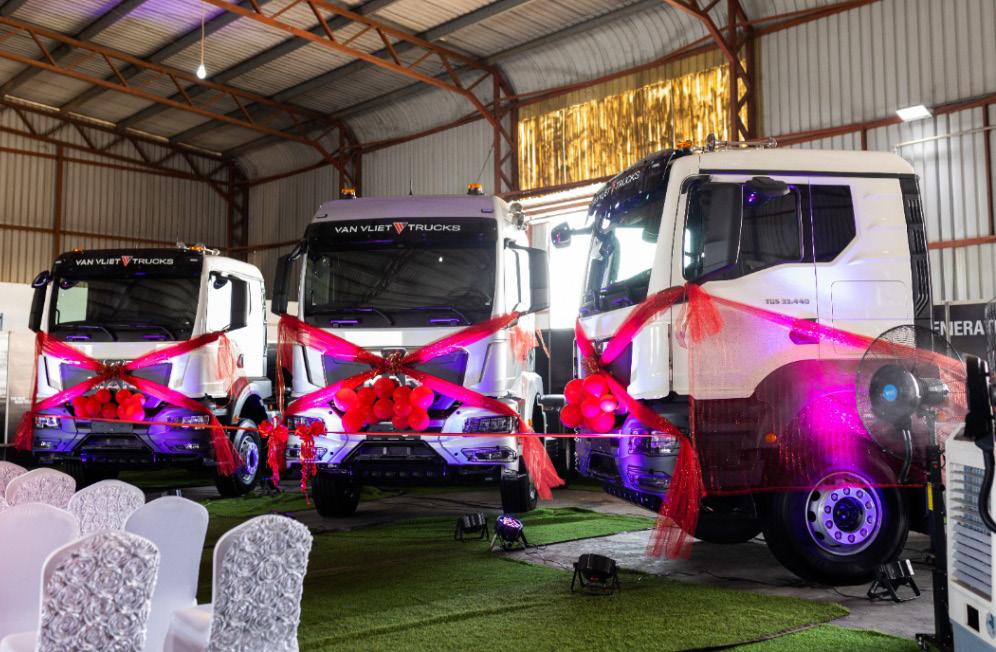
The development of the new trucks was based on customer feedback, to provide vehicles that meet their operational requirements – for today and for the future.
The new range represents MAN Truck & Bus as a provider of sustainable transport solutions. It underlines the high competence of MAN’s engineering team which has always delivered robust, reliable and efficient vehicles. These trucks also showcase the high build quality in MAN factories.
The New TG Range wears a distinct look with a new cabin that makes it stand out among its competitors. The new look is both visually appealing and functionally efficient. These vehicles offer the highest levels of reliability and efficiency for diverse applications & operating conditions.
Speaking at the event, Jens Terkelsen, Managing Director of Van Vliet Automotive Ghana Ltd and COO (Van VlietOverseas), said, “We are extremely proud to launch the New MAN Truck Generation in Ghana.
“The New MAN Truck Generation is an example of trucks that can meet the needs of the customers for today as


well the coming years. It eases the way our customers use our products and services and makes them more successful in their business.
“At Van Vliet, customer satisfaction has always remained a top priority. Combining this with the New MAN Truck Generation, we are confident that we will take the commercial vehicles landscape to the next level in Ghana”.
Joerg Mommertz,Senior Vice President, Head of Sales
Area Middle East, Africa and Latin America (MEA&LA), MAN Truck & Bus SE, said, “The launch of the new range is a milestone moment for all of us. It reflects MAN’s focus on helping our customers in their business.
“These trucks are built to be highly reliable; able to withstand rugged use over their typical operating life, while delivering best-in-class performance. As a result, customers get the optimum uptime and attractive Total Cost of Ownership.”
He added, “We have on offer a three-year warranty on the complete driveline on truck tractor models. We also have service contracts that can help customers in terms of preventive maintenance, predictable costs, optimised vehicle up-time and roadside/on-site assistance. Overall, we are offering the best ownership experience to customers.”

With the introduction of the new trucks, MAN also reaffirms its commitment to ‘Simplifying Business’ of its customers. The company aims to do so with effective aftersales for service & parts; a range of digital & financial solutions; and business advisory, besides reliable and efficient products.
Among the digital solutions on offer is the telematics suite from MAN. This is a powerful enterprise-grade solution for customers and it is designed to support im- proved levels of fleet efficiency & safety, and reduce environmental impact.
The engine range remains robust, reliable and efficient as before. It will continue to deliver consistently high performance over long duty cycles. MAN is the only truck maker to offer engines that conform to emission norms ranging from Euro 2 to 4, 5 and 6 depending upon the selected model.
Substantial improvements on the product, and in the areas of maintenance & service can reduce service life costs. These trucks also offer significant pay-load advantages for weight-sensitive application sectors.
Partnership has been key to MAN’s successes and its importer partners have done a commendable job to achieve customer satisfaction. The New TG Range also follows a product logic, which is oriented towards the application profile.
This allows for a new MAN TGX, TGS, TGM or TGL to be put together that fits the exact transport task, using flexible configuration options.
Optimised uptime – utmost availability over the entire service life
The operational efficiency of a truck is largely dependent on the parameter of reliability and how easily it fulfils its task, each day. MAN endeavours to make the tried & tested even better with the New TG Range.
These trucks will perform just as before as the powertrain retains its characteristics from the previous generation.
The new simplified and powerful electronic architecture supports the trucks’ functionalities even better and makes the New MAN Truck Generation particularly fit for the future.
In order to optimise the workplace in the truck, their performance and motivation need to be placed at the forefront. This is why the new MAN Truck Generation sets standards in terms of user-friendliness, optimum ergonomics, and operation which is more intuitive and reliable.
There is also the aspect of optimum space – a wellthought-out storage concept and perfect sleeping comfort. The ultimate achievement is a driver who is well-rested, comfortable and alert at all times, which leads to safer and more efficient operations each time. MAN ProfiDrive offers additional targeted and practiceoriented training to help drivers with more efficient and safer driving methods.
The new MAN TGX is the International Truck of the Year 2021
In addition to its driving comfort, the driver’s workplace with its clearly arranged, fully digital display instruments, the intuitively operable driving and multimedia functions incorporated into the new, generously adjustable multifunction steering wheel and the innovative, distraction-free rotary pushbutton control function of the MAN SmartSelect system impressed the jury of the International Truck of the Year.
The jurors were just as positive about the living conditions in the new driver’s cab as with the high level of safety. Last but not least, the new MAN TGX made a particularly trendsetting impression thanks to the high degree of connectivity provided by its electronic architecture, which is the first of its kind in the commercial vehicle sector. MAN Truck & Bus and Van Vliet Automotive Group are excited to be offering this new range to the Ghanaian market.
“We look forward to hearing the thoughts of our existing MAN customers and our new customers as they step into this truck generation and experience it for themselves.”
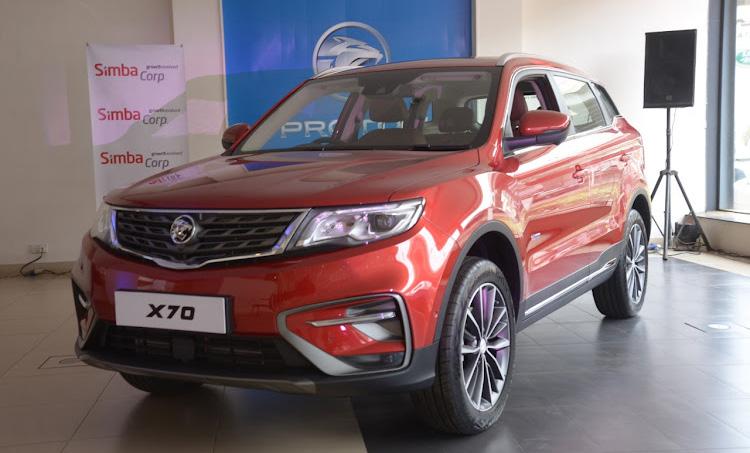 By Melinda Kirwa
By Melinda Kirwa
Simba Corporation has launched Proton X70 in the Kenyan market as it seeks to tap the slow, but growing demand for new cars.
The Sh 4.8 million SUV is the flagship model of the Malaysian car brand Proton.
Kenya's monthly new car sales increased in September as the automotive market picked from a slowdown in August.
Latest Kenya Motor Industry Association (KMIA) data shows sales for the month under review increased to 1,092 units up from 954 units in August, with Isuzu East Africa continuing to dominate the market.
Nine-month sales however fell short of last year’s numbers with the 18 dealers in the market selling a total of 9,868 units.
These are 49 units less compared to the 9,917 new cars sold in the local market in the same period last year, signaling the slowdown during the elections will affect this year’s total sales. Last year, a total of 14,250 units were sold.
These are both entirely built units and knocked downs, which are
delivered in parts (imports) and assembled locally. Since its inception into the Kenyan market in 2020, Proton has sold over 150 vehicles.
Simba Corp said that it has invested over Sh243.1 million ($ 2 million) into Associated Vehicle Assemblers (AVA) for the local assembly of Proton vehicles.
Proton SAGA was the first fully built salon car locally assembled at the Simba Corp AVA facility established in Mombasa. Speaking during the event, Simba Corp CEO Dinesh Kotecha said that the local assembly of Proton SAGA has helped introduce the Proton brand into the Kenyan market.
“We are very excited that the market has embraced this brand and we are happy to continue introducing new Proton products into the market,” Kotecha said.

Malaysian High Commission Charge D’Affaires Fatin Haris said that Kenya is a very important market for Malaysia and a leading partner with East Africa.
“Currently Kenya is Malaysia’s

number one export destination for Malaysia’s products in the African continent,” Haris said.
She said that the total trade value has increased by 84 percent over the previous year.
“These developments have been made possible by the goodwill and cordial relations that exist between the Republic of Kenya and Malaysia,” she said.
The number of new cars sold in the market is, however, a small margin of used imported cars on Kenyan roads, which the majority of households
tend to prefer mainly due to their lower prices.
Kenyans import an average of 7,000 to 9,000 used cars a month mainly from Japan (80 percent), the United Kingdom, United Arab Emirates, Singapore, and South Africa.
According to a TechSci Research report, growing demand for performance cars, increasing product offerings, rising preference for offroading activities and expected entry of several automakers will drive the sales of SUVs in Middle East & Africa through 2023. The report said that the Middle East and African SUV
market is projected to reach $ 46.9 billion by 2023.
“This is on account of growing per capita income, technological advancements in SUV and foray of several automakers in the region.”

It said that the growing popularity of SUVs for off-roading sports tournaments and increasing preference for premium SUVs would positively influence the region’s SUV market.
“Demand for SUVs in the Middle East and Africa region is anticipated to keep growing in the coming years.”

 By Joe Bush
By Joe Bush
Anew study has revealed a high demand for knowing the origin and sustainability level of materials and parts in automotive manufacturing, as well as receiving an end-to-end view of the manufacturing process.
Zebra Technologies Corporation has released the findings of its Automotive Ecosystem Vision Study which confirmed automotive

manufacturers are under pressure to accommodate growing consumer demands for sustainability and transparency throughout the manufacturing process and fleet managers’ need for the digitisation of operations and supply chain. Despite a fluctuating economy, automotive manufacturers are ready to invest in technology innovation as seven-in-ten expect to increase their tech spend and six-in-ten plan to increase their manufacturing
infrastructure spend in 2023.
Spanning multiple generations, consumers are the driving force behind automotive manufacturers’ acceleration to technology innovation as eight-in-ten say sustainability and eco-friendliness are key priorities in their vehicle purchase and lease decisions. Eighty-seven percent of Millennials prioritise sustainability in their vehicles followed closely by 78% of Gen Xers and 76% of Baby Boomers.
Consumers are also driving the growing emphasis on personalisation – the ability to customise a vehicle to their liking. Nearly four-in-five consumers say personalisation options factor into their decision to purchase a vehicle, and eight-in-ten fleet managers share these same requirements for sustainability and personalisation. While nearly 80% of automotive industry decision-makers recognise consumers expect more sustainable and personalised vehicle options today, seven-in-ten concede it’s
difficult to keep up with increasing customisation demands. As a result, three-fourths of automotive manufacturers say a top priority is to build strategic partnerships with tech companies for their next generation of production.
“There’s no doubt the automotive manufacturing ecosystem is undergoing a seismic shift with huge hurdles to cross. This includes essentially running two distinct manufacturing processes – one for traditional gasoline/diesel vehicles and the other for next generation electric, hybrid and autonomous self-driving vehicles,” said Stephan Pottel, Automotive Industry Lead, Zebra Technologies. “The pressure to meet regulations, demands for sustainability as well as do more faster and provide real-time visibility throughout the supply chain is daunting. With the right strategic investments in technology, the automotive industry can meet and even surpass these expectations and better serve their customers.”
The survey results also reveal stronger preference to purchase electric vehicles (EV) in the future with more than half of consumers indicating their future preference is for a hybrid electric vehicle (HEV). However, navigating this increasing demand for EVs comes with challenges as 68% of automotive industry decision-makers say they are under high pressure to produce next generation (i.e., electric) vehicles, and 75% of them are under high pressure to deliver products that are more eco-friendly, sustainable and safer for the environment.
Trust and transparency in automotive manufacturing

Data and information transparency is highly important to consumers and fleet managers alike, and they’re seeking more visibility into the automotive ecosystem. When considering a vehicle for purchase or lease, 81% of consumers and 86% of fleet managers indicate they want to understand the origin and source
of materials and parts on their vehicle. Millennials lead the way for more transparency in automotive manufacturing, with eight-in-ten saying it’s important to have access to the origin of materials and parts, knowing if source materials and parts are sustainable and understanding how the vehicle is manufactured from end-to-end.
Beyond gaining greater visibility into the automotive manufacturing process, once they have their vehicles, 88% of consumers and 86% of fleet managers want to understand how the data from their vehicles will be used by the automotive ecosystem. After a vehicle purchase, 83% of consumers and 84% of fleet managers expect ownership and control of the data their vehicle generates.
Automotive supply chain visibility
A majority of consumers and fleet managers (80%) want end-to-end visibility during the manufacturing process. However, only about one-third of automotive industry decision-makers say they will prioritise connecting real-time data systems to enable a holistic view of operations and increase visibility across production and throughout the supply chain over the next five years.
About one-third of original equipment manufacturers (OEMs) said autonomous mobile robots (AMRs), RFID, rugged handheld mobile computers and scanners as well as industrial machine vision will improve supply chain management while about one-third of suppliers cite mobile barcode label/thermal printers, wearable computers and location technology as the technologies to do so.
Overall, seven-in-ten automotive industry decision-makers agree digital transformation is a strategic priority for their organisation. In the next five years, they anticipate expanding their use of technology across the board with 47% focused on additive manufacturing/3D
printing and 45% on supply chain planning solutions. Key regional findings
Eighty-three percent of automotive industry decision makers agree the pace of technological innovations is accelerating at a rate their organisation is struggling to keep up with; this is the highest of any region.
They feel they are under pressure to build strategic partnerships with technology companies in order to cut costs and mitigate risk with next-generation mobility production (83%) as well as greater visibility across the supply chain (83%).
Automotive industry decision makers are increasingly focused on expanding sustainability, waste reduction, and environmental protection initiatives.
Twenty-seven percent say these initiatives are drivers of financial performance and growth, and 49% expect it to be within the next five years.
Nineteen percent of automotive industry decision-makers foresee an increased focus on internal combustion engine (ICE) vehicle production over the next five years.
Meanwhile, 39% of these decision-makers are also building capacity for next-generation options, such as electric vehicles.
Consumers are the most concerned about the use of data collected from their vehicle at 80% compared to the global average of 74%.
Nearly half (47%) of fleet managers would like to see the automotive industry focus on ensuring automotive data is kept safe, secure, and private, compared to 32% globally.

The world is at an environmental crucible with harmful carbon emissions in the last ten years achieving their highest level in human history. This has put climate change at the forefront of global priorities, with governments, industries and local communities joining forces to reduce fossil fuel use, increase the use of alternative fuels, extend access to electricity, and improve energy efficiency.
Therefore, it is no surprise that the automotive industry has emerged as a key stakeholder in achieving these goals, given the major impact it has on the environment. Re-inventing mobility is not a luxury but a must to reduce carbon emissions and global warming.
This has been reflected in the dramatic disruption taking place in the automotive industry in the last decade, led by stricter regulations aimed at reducing CO2 emissions by 55% before 2030, technology advancements, and unprecedented investments in sustained mobility.

The result was an increased adoption of electric vehicles across the globe, emerging as the preferred clean technology for the future of mobility.
And just to give you a sense of where the market is heading:
• From 2010 to 2020, the number of electric vehicles globally grew from 17,000 to 10 million.
• In 2021, 7 million more EVs were sold, accounting for 10% of global car sales in that year and 40% of the total volume of EVs sold during the last ten years.
• The number of EVs is expected to reach 145 million globally by 2030, growing 6 times faster than the global automotive market.
• Out of the world’s top 20 vehicle manufacturers, 18 plan to scale up their EV production.
• 300$ billion dollars were invested globally to develop EVs in the last ten years and another 515$ billion dollars in investments are planned through 2030.
On another hand, the cost of operations of EVs for consumers is expected to be 40% less than that of our regular internal combustion vehicles.
Moving to electric is vital, especially in light of the government’s efforts to reduce the burden on citizens, attract further foreign investments, strengthen local manufacturing capabilities, create jobs, and raise Egypt’s innovation profile.
“
The automotive industry in Egypt is witnessing a much-needed boost thanks to the government’s efforts to create a true dialogue with key market players, improve the business environment, establish a strong local manufacturing base and help the industry shift towards sustainability in line with global practices and the wellbeing of its citizens.

Shifting the automotive industry in Egypt to electric vehicles could be a major contributor to Egypt’s National Strategy for Sustainable Development that aims to achieve a 50% reduction in pollution and 42% share for renewables in its energy mix.
With almost 25% of our CO2 emissions being attributed to transportation, using environmentally sustainable mobility will considerably improve air quality and reduce solid particle pollution.
A typical passenger vehicle emits about 4.6 metric tons of carbon dioxide per year and there are on average 300,000 new cars sold in Egypt annually. If we achieve one out of every ten cars to be electric over the next decade, we could save 1.4 million tons of CO2 emissions. We could also save USD 45 million / year in healthcare expenses for every 1000 electric buses that we deploy, according to a previous study by the International Finance Corporation.
Today Egypt has five main factors that will facilitate achieving its sustainability goals and establish a strong EV market:
1. A young population with a bigger appetite to take the lead in adopting new technologies.
2. An affordable alternative in the mid to long-run to reduce our dependence on fossil fuel.
3. With the growth being witnessed in infrastructure and the creation of new cities, the ability to set new policy and organization goals and the commitment to international standards in urbanization.
4. The proximity and trade relations with Europe and Africa, maximizing the potential of our location and our existing free trade agreements to make Egypt a center of excellence for EVs in the region.
5. The government’s dedication to localize the manufacturing of EVs in Egypt, strengthen the charging infrastructure in the next three years by building 1000 local charging stations, regulate charging fees, decrease taxes, and facilitate licensing.
Al Mansour Automotive Group has been a leader of the Egyptian Automotive industry for the last 47 years, and today, it is laying

the foundation to maintain its market leadership in the new paradigm shift taking place in the automotive industry, by focusing on innovation and sustainability, and actively taking part in the transition to EVs in Egypt.
Mansour Automotive sustainability strategy is centered on four key objectives:
• Become the EV market leader in Egypt.
• Locally assemble EVs.
• Support mobility solutions developed by Egyptian startups and innovators.
• Support renewable energy and set up EV charging infrastructure through its group company Infinity.
Our strong belief in the future of clean energy and sustained mobility is what motivated us to be part of the presidential automobile conversion program, to work closely with the government on developing Egypt’s Automotive Industry Development (AIDP) Strategy with a focus on EV localization and adoption, and to be the exclusive mobility principal partner for the Climate Change Conference COP27 which will be held in Sharm El-Sheikh in November 2022
Egypt is a promising market with numerous investment opportunities especially in the mobility sector. Moving to electric is vital, especially in light of the government’s efforts to reduce the burden on citizens, attract further foreign investments, strengthen local manufacturing capabilities, create jobs, and raise Egypt’s innovation profile.
This is an exciting time, witnessed only once a century and we are lucky to be part of it. There are countless opportunities to be seized and a lot of impact to be made, and we look forward to you becoming part of our journey! Stay tuned for more exciting announcements during COP27!
 By Martyn Davies
By Martyn Davies
When listening to our clients spread across the world in the automotive ecosystem — the original equipment manufacturers (OEMs), leading suppliers, retailers and technology providers — we have identified a number of key trends that are affecting and shaping the industry.
The industry megatrend in recent months has been supply chain disruption. The chip shortage has had a major effect on the automotive industry, cutting production by roughly 7.7-million units and causing $210bn in revenue loss in 2021.

Previous confused information within the supply chain resulted in inaccurate or exaggerated demand forecasts. And with only weak links between vehicle makers and foundries, it has become extremely difficult for the overall industry to react to changes in demand.
Automakers still rely largely on just-in-time sourcing strategies using short-term forecasts, which offer little to no buffer — despite 26-week lead times for semiconductors. Many components are also sourced from a single producer and subject to strict quality requirements. All these factors have limited the flexibility of the supply chain during the recent shortages.
OEMs have allocated scarce chip stocks to premium and luxury vehicles with historically higher profit margins. As a result, production volumes of smaller vehicles (A and B segment) have been disproportionally affected. The chip shortage has put significant strain on automotive suppliers, especially for the volume segment, which were already hurting from lockdowns and pandemic-related closures.
Constant high cost pressures due to ongoing shortages of raw materials are undoubtedly constraining investment opportunities.
Semiconductors have become an integral part of the supply chain for many industries. Chips power everything
from cars and smartphones to industrial equipment, and are also a key enabler for widespread adoption of emerging technologies such as AI, quantum computing and advanced wireless networks such as 5G.
This is one key reason all six of the major end-use categories for semiconductors continue to grow, whether it is automotive, industrial, consumer, data processing, military-civil aerospace or communication. According to Gartner, the automotive segment is expected to see annual growth of 15.6% from 2020 to 2024, the highest of all six categories.
Owning factories is a costly investment, which is why so many semiconductor firms prefer to outsource production to foundries overseas, particularly in Taiwan. Taiwanese contract manufacturers (such as TSMC) dominate the semiconductor manufacturing sector, accounting for more than 60% of total global foundry revenue in 2020.
To diversify and address shortages, chip manufacturers recently announced new investments that include:
TSMC will spend $100bn over the next three years to expand its chip production capacity;
Intel dedicated a portion of the production at one of its largest non-US foundries for the automotive sector;
Sony Group invested $500m in a joint venture with TSMC to build a $7bn chip plant in Japan; and Samsung is planning a $116bn investment over the
next decade.
However, it will take a few quarters to get production going, and many of these investments are targeted towards high-end chips, a future demand, even though it is low-end chips — especially those for the automotive sector — that are in short supply at present. We expect the automotive chip shortage to continue until mid-2023.
Climate change and tighter regulation of carbon dioxide emissions is a global imperative that will prevail for decades to come. It is the key driver of what is referred to as the “transformation of the industry”.
The fact that leading OEMs use their key market regions as a differentiator is an additional factor. European OEMs tend to focus on Europe and China, while Japanese OEMs tend to prioritise the North American and Japanese markets. North American OEMs primarily target their own home market, often with one additional region in the mix. Suppliers are thus facing different challenges depending on the region they are active in and the OEMs they supply.
The automotive supplier sector has not agreed on a single reporting standard for environmental, social and corporate governance (ESG) compliance, and many are even using multiple standards. Adding more complexity, several top auto suppliers lack a common format or approach to reporting — running the gamut from sustainability reports to integrated reports with financial details and from corporate social responsibility (CSR) to combined reports.
Suppliers have largely been waiting for further direction from OEMs before aligning their own mid- to long-term strategies. With OEMs having now (mostly) committed to EV power trains into the future, suppliers will increasingly focus on how fast consumer sentiment will shift from internal combustion
engines (ICE) to electric vehicles. We have seen a huge rise in inquiries from both suppliers and OEMs related to strategies seeking to reduce their carbon footprints after last year’s COP26 climate summit held in Glasgow.
Suppliers in Europe face the strictest CO2 regulations. We expect ICE vehicles to disappear from the European market by 2035. Suppliers with a strong focus on ICE-related products will need to shift their business towards other products or face extinction. As a result, we are seeing many companies look to carve-out or spin-off strategies for their ICE-related product ranges. However, selling businesses with a high ICE exposure has increasingly become a challenge if not an impossible task.
The (ESG and carbon) regulatory environment in Africa is lax in comparison, with low to zero control of carbon and sustainability targets.
Global suppliers are now revamping their businesses for the future and focusing on key disrupters such as electrification, software-as-a-service, connectivity and autonomy. The focus of automotive suppliers is very much on making value chains more flexible to be able to react more quickly to uncertainties, but also to

drive forward the development of new products and services gaining additional profitability.

The adoption of digital technologies is supporting this transformation. Whether it is a smart factory or distribution centre with automated product and picking lines, a shift to cloud-based systems to unlock business efficiencies or the move to online spare parts sales, digital technology is enabling these processes.
The increasing share of software in vehicles and the associated necessity to build up own software development capacity is clearly in focus. Much opportunity lies in analytics in the wider automotive and mobility space and how data is effectively used by both consumers and companies.
Overall, the challenges remain over the short to medium term, even if successes are clearly beginning to emerge. The increasing complexity of supplier and industry transformation is being driven by digitalisation and commitments towards sustainability. aThe new automotive ecosystem will have to be built around these two imperatives and will have a significant impact on how automotive supplier value chains are configured going forward.
Supply chain disruption makes it difficult for the sector to react to changes in demand. The challenges remain over the short to medium term, even if successes are clearly beginning to emerge
“

 By Arun Krishnamurthi
By Arun Krishnamurthi
The automotive industry is undergoing a radical transformation driven by rapid technological advancements and heightened market competition. As autonomous driving, cloud computing, electric vehicles, and networking become more intertwined with the industry; consumers can now enjoy a more enriched experience. So how can industry players leverage the latest technologies in this new era to stay ahead of the curve?
Technology has been on a continual upswing since it arrived in the mid-twentieth century and will only become more advantageous in the forthcoming years. We have seen
 Managing Director/CEO, Axiscades Technologies Ltd
Managing Director/CEO, Axiscades Technologies Ltd
immense progress over the last ten years since its arrival due to the unveiling of new and advanced technologies that have propelled us forward and bettered people’s
lives all over. Furthermore, this generation’s curiosity surrounding digital technology and artificial intelligence has led to thoughtprovoking forays into ingenuity
and opportunity, providing myriad benefits to society. This is a boon for society, and we eagerly anticipate seeing what the upcoming decades have for us.
Without a doubt, Artificial Intelligence is becoming an increasingly important part of the automotive industry, and the reasons behind this are increasing every day. The market for automotive artificial intelligence was worth USD 2.54 billion in 2021 and is anticipated to expand at a CAGR of 21.6% from 2022 to 2030. The rising demand for autonomous vehicles, the favourable application of AI in traffic management, advanced automotive solutions, and government initiatives are the main drivers of the worldwide automotive AI market.
AI is taking cars to a level where many thoughts were unattainable until recently - from diagnosing
maintenance issues in advance to rendering the roads safer for everyone. As a result, automotive giants are taking advantage of AI to streamline their processes and enhance security while at the same time minimizing costs and manufacturing time. AI plays such a vital role that it’s formidable to envision car manufacturing without it.
Considerable use-cases of AI used in car manufacturing:
-Design: AI is used to help car manufacturers design efficient and stylish cars.
-Simulation: With Digital Twin - a simulation-based endeavour - manufacturers can reduce time, money, and resources while still meeting their quality standards.
-Data Analytics: The future cars will be continuously monitored and adjusted according to the data they collect, making cars more efficient, safer, and reliable.
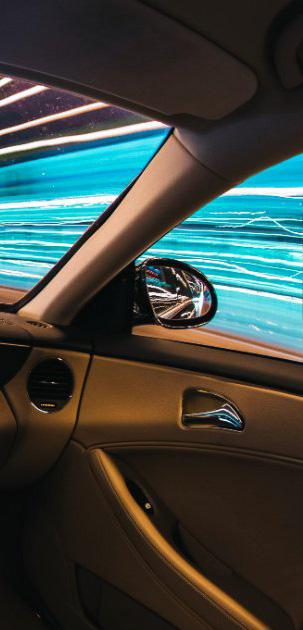
-Torque measurement: AI is used to help car manufacturers better understand and predict vehicle torque - a crucial factor in proper car operation.
-Testing: AI is being used to monitor and predict the performance of cars in extreme conditions.

-Safety Features: AI can also be used to enable object detection, lane detection, and pedestrian detection, potentially making roads and highways safer. AI-enabled real-time monitoring can also alert drivers of potential road accidents and advise them of the best courses of action to take to avoid them.
-Self-Driving: Advances in AI technology have made self-driving cars a reality. Several automakers, such as Tesla, Ford, BMW, and Toyota, are already deploying autonomous vehicles in select areas.
-Driver Behaviour Analysis: IoT sensors are installed on the vehicle
to track and analyze the driver’s behaviour. Additionally, these can serve as early warning signs to monitor driver responsiveness and provide a signal to warn them of any unusual behaviour and its potential consequences for the car.
Automobile companies are swiftly recognizing the importance of integrating Artificial Intelligence into their operations to stay competitive in today’s market. The incredible capabilities of AI in car production are reason alone to make it the new industry standard.
Implementing AI in tracking parts and delivery enables us to achieve higher levels of efficiency and accuracy. This has the desirable effect of leaving more time for people to focus on more critical tasks, thus freeing them up to do what they do best.
AI will be used to map out routes and anticipate traffic lights. Using sensors and cameras, Automotive Vehicles (AVs) can detect obstacles and plan a route around them that is as smooth as possible. This capability will make travelling in congested cities much more accessible.
AI is invaluable for companies in predicting customer behaviour, enabling them to create more detailed customer profiles and render superior services. By leveraging AI, customers can be provided with effective troubleshooting solutions in no time, coupled with tailored recommendations to improve their car ownership experience. Moreover, by tapping into the power of AI, customers can avail of a seamless service experience while also saving time and money - it’s a win-win situation!
AI can help to enhance the driving experience by providing warnings about potential collisions or helping to plan routes. AI is also being used to improve vehicle operations’ efficiency and help drivers avoid traffic congestion.
AI transforms vast, complex data into clear insights via beautiful, easy-to-read reports and engaging dashboards. AI also automates and improves fleet management decision-making with the help of state-of-the-art image recognition, advanced analytics, and driver behaviour and weather conditions.
AI’s strongest suit is its ability to inspect automotive parts and products over time, enabling its ML algorithms to strengthen in identifying shortcomings over time.
From 2023 to 2027, the market for autonomous vehicles is projected to expand by $319.41 billion, with a CAGR of 38.45%. And what’s fuelling this remarkable phenomenon? Artificial intelligence. The power of AI is evident in the AV market, forming the very foundation of the technology needed to get us to an autonomous future and is what essentially helps drive these cars. AI will play a significant role in driving assistance, driver monitoring, predictive maintenance, aiding in emergencies, and more.
The automotive industry quickly realizes the immense potential of augmented reality (AR) and virtual reality (VR). These cutting-edge technologies are helping automakers create more intuitive user interfaces and offering new ways of engaging with customers. In 2017, the global automotive augmented and virtual reality market was valued at USD 213 million. By 2025, this figure is predicted to soar to a staggering USD 673,602.2 million, with a CAGR of 175.7%. We expect to see numerous advancements in AR
and VR in the coming year, with applications ranging from car design and production to enhanced vehicle safety. AR and VR are set to revolutionize the automotive industry soon.
AR promises to make it easier for people to see what a car will look like in the real world, and VR can help drivers become more familiar with alternate driving routes and car crash scenarios. The automotive industry is expected to see even more widespread adoption of these technologies in the coming year, thanks partly to new developments in computing and optics.
By letting drivers see the surrounding area more realistically, they can better plan their routes and avoid accidents. Here is a list of the most creative applications for AR in the automotive industry:
√ The driver may get visual data about the surroundings, road circumstances, and navigation through the windshield using augmented reality services.
√ With AR headsets, the learning process is automated for those who manufacture or maintain cars

The way automobile manufacturers design their vehicles is changing due to the immersive 3D capabilities of VR. With VR, designers can craft accurate designs and integrate them into prototypes much faster. Plus, designers can now represent designs in 3D - at the actual scale - instead of relying on 2D sketches or CAD concepts. This clarity provides much better insight into how a design will function in real life, ultimately making development more efficient and cost-effective. With the help of virtual reality, automobile design is entering a world of unprecedented possibilities, making the entire process more efficient and convincing.
Secondly, with the help of virtual prototyping, VR makes iteration much more efficient and cost-
effective by removing any constraints on the design and review processes. Not only does this process of trial and error allow for more accurate results, but it can also dramatically reduce business development costs. This is a great way to ensure success without wasting resources.
The metaverse is a virtual reality world constantly evolving, and it will have a solemn impact on the automotive industry on all levels. At a forecasted CAGR of 31.4%, the global automotive metaverse market is expected to increase from USD 1.9 billion in 2022 to USD 16.5 billion by 2030.
As we all know, automotive companies are always looking for ways to increase their market share and improve quality products. But what if they could do that with lower development cycles and betterquality products? That’s what the metaverse is going to bring to the table.
The metaverse is poised to have a fascinating and profound effect on automotive organizations of all sizes. Shortly, we can foresee the intensifying of integration and collaboration among automotive companies and their suppliers, partners, and internal teams. As a result, we may experience shorter product cycles with premium products.
All of these uses of AI will have a significant impact on the automotive industry in 2023. By making driving safer, easier, and more efficient, AI will play a key role in helping to change the way people use cars and make them a much more critical part of their lives. Some of the points mentioned above have already sparked changes, and others will impact the subsequent year. This revolutionary transformation pushes the automotive industry to think outside the box and explore new horizons.
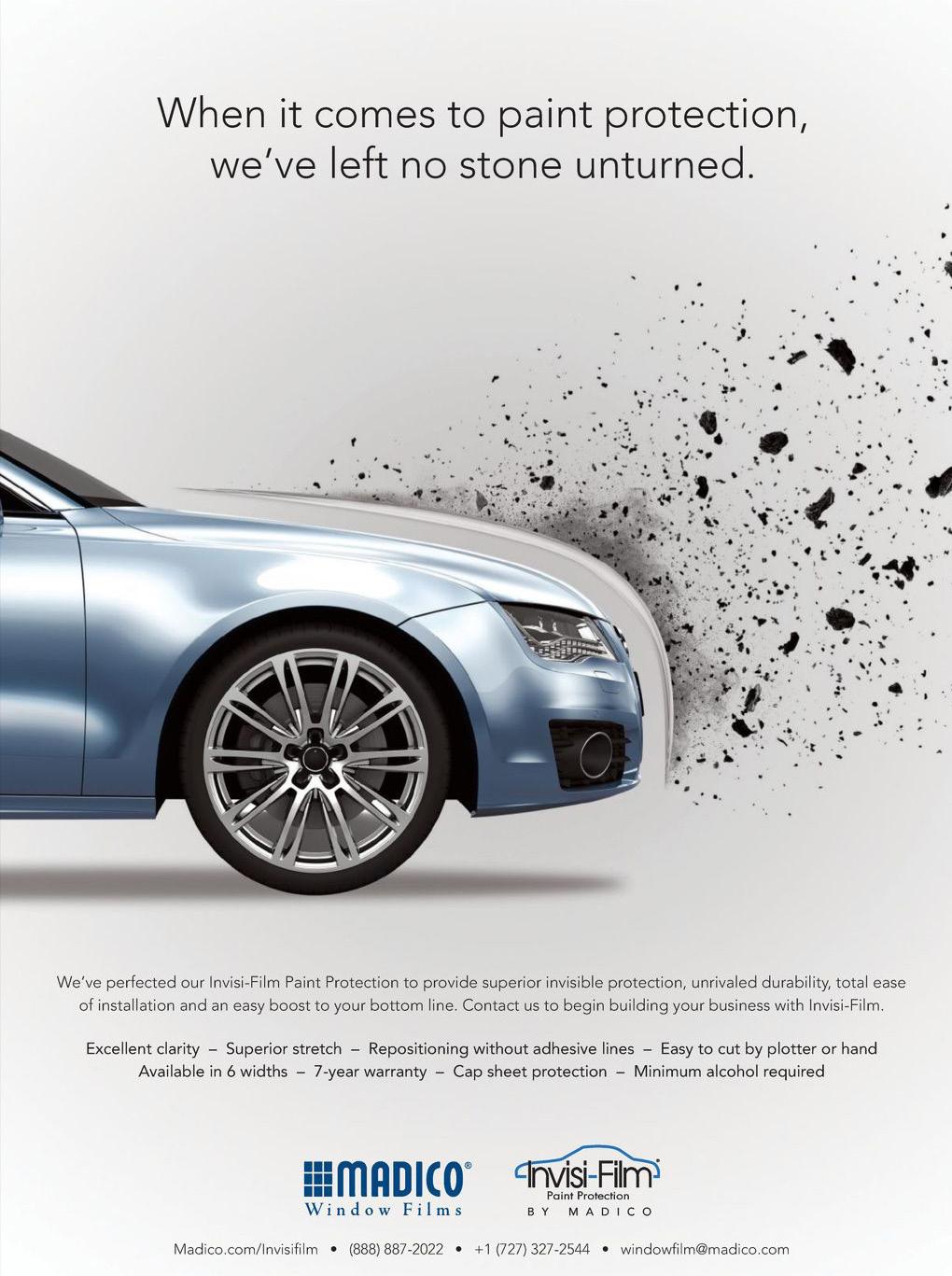



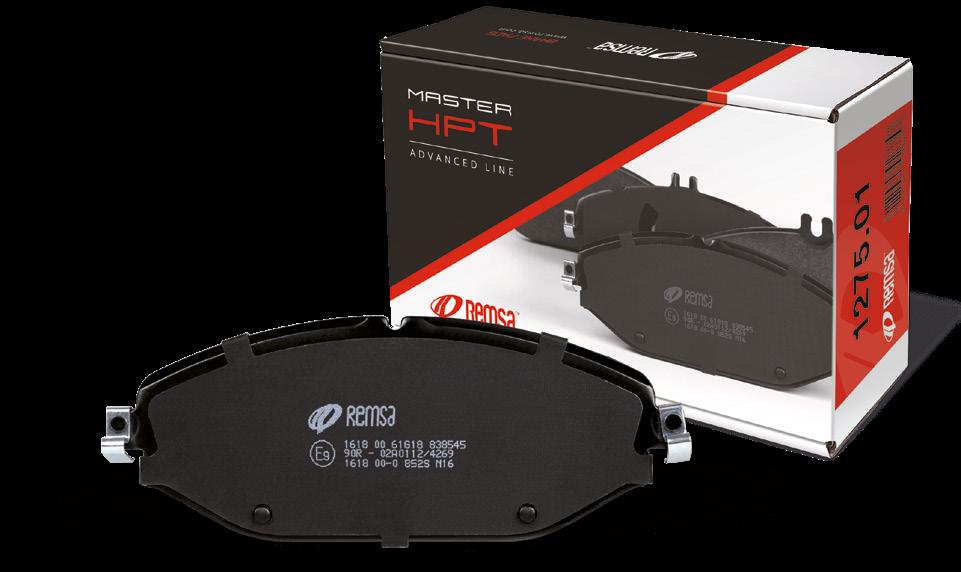




UltraSense Systems has announced In-Plane sensing automotive technology, the ability to enable multimode sensing and HMI control in the plane of the SmartSurface (or A-Surface), drastically reducing the size, weight, enabling modern designs and offering highly configurable optionality, that reduces part numbers and build complexity. This translates to advantages in sustainability and recyclability, increases driving range, and enables modern designs and new user experiences that were not possible before such as supporting controls for retractable steering wheels that require elegant slim form factors.
In-Plane sensing is a major step towards the ability to deliver a full HMI experience by enabling the thinnest possible space. This is more than a capacitive ITO layer, but as defined by offering sensor fusion and enabling multimode sensing, processing & algorithms, feedback control: illumination, audio, haptics, and secure connectivity. It is a recipe for transformational changes in reducing the size of existing automotive module depth. Combined with the TouchPoint family of HMI controllers, InPlane sensing enables designs that support all types of Smart Surface HMI interactions through the broadest set of materials, beyond capacitive plastic
and glass. Smart Surfaces can now operate through natural materials such as wood and leather to metal and other soft surfaces.
"Traditional interface modules were measured in inches of thickness, with In-plane sensing we are talking about millimeters of surface thickness, with full solid-state HMI controller capabilities, of multimodal sensing and feedback control of lighting, audio and haptics," said Mo Maghsoudnia, Founder and CEO of UltraSense Systems. "InPlane sensing principles combined with our TouchPoint family of HMI controllers deliver the thinnest HMI operating through the broadest range of materials. This technology is applicable for HMI experiences for automotive interior and exteriors, industrial, and consumer applications."
InPlane sensing is a design structure and works with all TouchPoint HMI controllers and sensors, offering new thin designs as well as the
traditional, thicker force pillar designs.
All TouchPoint HMI controllers offer
Multi-Mode sensing (CapForce, UltraForce, TapForce) Processing and AI Machine Learning algorithms Feedback control to drive Illumination, Audio and Haptics
Secure Connectivity options to support industry protocols such as LIN and CAN as well as offering configurability – optionality, technology upgradability that is offered at production, dealership, or end-user Over The Air updating.
UltraStudio 2.0 is a HMI User eXperience design and human factors evaluation tool to help facilitate testing and comparing various settings of touch to feedback, including illumination, audio and haptics. It helps accelerate the product development phase of the HMI end user experience.


 By Bob O’Donnell
By Bob O’Donnell
The automotive industry has gotten its fair share of time in the spotlight in recent years. Part of the focus has revolved around how important semiconductors are to modern vehicle designs equipped with smart technology capabilities. These technologies aren’t just limited to the fully electric or hybrid models, which have existed for years now, but have expanded to include SUVs and minivans outfitted with a tablet on the dashboard and a camera built into the rearview mirror. With Deloitte projecting that 45% of the cost of a new car will come from electronic systems by 2030, the importance of chips is only growing.
This is especially true with FPGAs. The most technologically advanced cars can have up to 10-12 FPGAs inside them, all performing varying functions given their inherent flexibility and small size. From infotainment systems, advanced driver assistance systems (ADAS), in-cabin artificial intelligence for human presence detection, and secure battery management, FPGAs are spread up and down vehicle designs and are making cars smarter than ever before.
As more technology has been added to vehicles over the years like cameras and sensors, designs have begun shifting to zonal architectures, or different computing “zones” throughout a car that all relay and connect to a main computing component, usually a system on chip (SoC). Thanks to their bridging functionality, FPGAs are used to route the signal from different cameras or sensors by multiplexing the signals together only to separate them, or demultiplex, when they reach the SoC.
It may sound straightforward, but the connections between different zones can vary greatly from vehicle to vehicle and require different types of standards. Some cameras and sensors follow MIPI standards while others use high-speed SERDES for longer distance connections. Additionally, older automotive standards are still being used, including local interconnect network (LIN) bus, controller area network (CAN) bus and automotive Ethernet.
FPGAs with the appropriate specs have the power to work across each type of connection and server as a bridge between different standards, allowing for much more complex designs to be executed.

FPGAs aren’t just appealing to automotive designers for their bridging capabilities, but also for their low latency signal processing and analytics performance at a deterministic rate every, single, time. This consistent reliability is critical for a car’s performance in real-time based applications like assisted driving systems.

Looking at electric or hybrid vehicles as an example, FPGAs support high-performance pulse width modulation (PWM), allowing them to be used for finetuned motor control, power conversion, and inverters that all help to extend the range of vehicles by maximizing power and efficiency.
FPGAs are also suitable in electric/hybrid vehicle models because of their low power consumption. The higher the input/output (I/O) density, the more flexibility and adaptability FPGAs can deliver.
Just like they’re enabling robust cyber resiliency functions in applications like servers and telecommunication networks, FPGAs are doing the same for cars. Consumers need to be assured that their
Internet of Things (IoT)-connected vehicles cannot be tampered with by bad actors, so safety and reliability are critical. Security-grade FPGAs are used as a hardware root-of-trust for secure control in automotive applications, meaning the FPGAs can self-authenticate the integrity of its firmware and other devices that boot alongside it.

In addition to firmware security, the auto industry requires vehicle designs to follow strict regulatory standards for safe and consistent operation in a vehicle. One standard, ISO 26262 for functional safety, requires components to comply with the physical demands of the road like extreme temperatures, and to also have accompanying software that operates in a continuous safe fashion. FPGAs can run ISO 26262 certified software to meet the necessary standards.
Gone are the days of a non-computerized automotive industry. As more electronics are included in vehicle designs and interact with the rest of the vehicle, more room for error is introduced. This can lead to costly recalls and headaches for consumers, such as when Volkswagen introduced the ID electric car series and a battery self-discharge problem occurred, resulting in the company recalling about 10,000 units.
These seemingly minor components play a large role in the overall health of the vehicle, and these types of safety issues are only going to become more prevalent in the future. Thus, it’s the responsibility of the automotive industry to ensure that these components are incorporated in the safest and most effective way possible.
FPGAs are proven to be flexible and reliable components to enable a variety of different electronic capabilities in today’s advanced vehicle designs. Consumers expect their cars to keep evolving and to further integrate electronics seamlessly with their driving experience. It is up to manufacturers to embrace the challenge and master the tools they have at their disposal. With a new future dawning on the horizon, there are plenty of opportunities for these cars to keep getting smarter.
 By Ephraim Modise
By Ephraim Modise
Zimbabwean investment company, InfraCo Africa, has announced that it has signed a US$2 million (Z$723.8 billion) deal with mobility startup, Mobility for Africa, to deploy 400 electric vehicles to rural areas in the country.
The vehicles, called “hambas” (which means “go ahead” in the local Ndebele language), are solarpowered and assembled in the capital Harare.
According to a statement, the deal also includes the manufacture of 600 electric batteries and the installation of eight charging stations, with the aim of developing a sustainable transport system to stimulate sustainable development, particularly in communities not yet served by the national electricity grid in Zimbabwe.
Speaking on the deal, Shantha Bloemen, CEO of Mobility for Africa, said, “This partnership will enhance the role of rural women as key contributors to economic agricultural productivity, as well as gender equality and climate resilience as enshrined in the United Nations Sustainable Development Goals (SDGs).”
Founded in 2019, Mobility for Africa claims that its solutions will facilitate access to doctors for patients who reside far from health centres, as well as the transportation of goods to major Zimbabwean metropolises such as Bulawayo, Chitungwiza, Mutare, and Harare.
The InfraCo Africa and Mobility for Africa deal comes
on the back of two other landmark deals in the electric mobility sector in Zimbabwe.
In May, energy solutions company Zuva signed a contract with Electric Vehicle Center Africa (EVCA) to install a network of charging stations for electric vehicles in the Zimbabwean capital. In August, the European Union (EU) purchased 88 electric tricycles for women farmers in Domboshava, 27 km from Harare, to encourage the development of the green economy in the country.




 By Filum Ho
By Filum Ho
Your car’s windscreen is a vital component when it comes to your safety on the road. And with the summer rains upon us, you’ll want to make sure that you keep your auto glass safe, leak-free and clear.
Taking this into consideration, you should be aware of 5 things that you can do to ensure that your windscreen keeps you as safe as possible, especially if you need a replacement.
Listed below is a list of 5 tips that motorists should bear in mind this summer when selecting a credible glass service provider.
One way to ensure that your windscreen remains free of any leaks or cracks this summer is to get a specialist to run an ultrasonic leak detector over your automotive glass. An ultrasonic leak detector is a specialised instrument used to detect holes or gaps in the bonding agent that is used to seal the windscreen to the body of the vehicle.
If you are installing a new windscreen this summer, be sure to ask your workshop about ultrasonic leak detection. This technology guarantees a leak-free experience every single time.
Advanced Driver Assistance Systems (ADAS) comprise electronic systems that assist drivers in driving and parking functions, playing a critical role in vehicle safety. These systems use technologies such as sensors and cameras to detect obstacles or risks to the vehicle, and respond automatically to these dangers.
Therefore, it’s a non-negotiable that when replacing your windscreen, your car’s ADAS calibration is also done. If it is not, some of the vehicle safety mechanisms simply won’t work. In some countries, insurers have even been held liable for not providing calibrations on vehicles when they were necessary. Ensure that your service provider has the specialised calibration equipment necessary to make sure that your ADAS is done right.

Motorists should also be aware that their glass partners can use products such as Nasiol glass-shield wipe-on, which ensures safe driving in rainy conditions while protecting your glass and mirrors from UV irradiation and stains.
Using a water resistant nano repellent this ensures that you’ll always have a clear view of the road, no matter how many thunderstorms you drive through.
These days, consumers have more options when it comes to choosing OEE (Original Equipment Equivalent) or OEM (Original Equipment Manufacturer) auto glass installations. OEE parts and glass products are typically made in the same factory as their OEM counterparts, but they can often cost up to 300% less. It is a little known fact that car manufacturers do not manufacture their own glass. Some insurers even waive the excess when you opt for OEE glass. So in these economically difficult times, OEE glass is not only kinder to your bank balance but also has exactly the same safety and quality standards as OEM glass.
Finally, many of us like to make sure that we see the SABS mark of approval on products such as our windscreens. However, it's important to know that the SABS standard doesn't measure quality in terms of the form and fitment of your windscreen.
If the form and fitment aren't correct, then there is a greater chance of wind noise and leaking. If you opt for an OEE glass product, it's important to look out for the likes of the E Mark, Dot Mark, and CCCs (these are the internationally recognized standards of quality for glass in Europe, The United States and China) as well as the SABS quality stamps of approval on the product.
As you can clearly see, there is a lot more to windscreen safety than meets the eye. But these 5 pointers can at least ensure that you navigate the wetter season on our roads with far greater safety and confidence.
If you have any questions, you can always ask our friendly glass experts at any Autoboys outlet across the country, who are more than happy to be of service.
It is tough to keep your car’s wheels in pristine condition. They are constantly exposed to external influences that adversely affect the wheel surface, causing scratches and chipping and can eventually result in a curbed wheel.

Damaged elements not only spoil the vehicle's appearance but also hurt the driving characteristics. During use, your wheel rims’ coats become dull, cracks and chips appear on the surface, and the factory paint flakes off. This results in exposed areas of metal that are destroyed by corrosive processes. And since wheel rims are integral to the car’s overall look, this aspect should always be in perfect condition.
Many drivers often wonder: what is a curbed wheel, what causes it, and how do you fix it? Today, it’s possible to service a curbed wheel at the service center with the latest coating restoration technology. However, few car owners know that they can repair curbed wheels themselves. Let’s find out how to do it.
Car manufacturers are increasingly turning away from
steel wheels, with aluminum-alloy and all-aluminum wheels becoming standard or available on most new vehicles. A curbed wheel, often referred to as curb rash, is a term used in the automotive world to describe a situation when a vehicle's wheel rim has sustained damage from being rubbed along a curb or when the driver has slightly misjudged a parking maneuver.
It is essential to know that while cheaper stamped rims are not repairable or restorable, cast and forged products should be regularly cleaned and repaired.

There are numerous ways to spoil your rims apart from rubbing them along a curb, for example, cleaning off the baked-on brake dust on the wheels using steel wool. This is a mistake that’s relatively easy to make. Steel wool scratches the clearcoat off clear-coated rims and grinds the metal of rims that don't. You might end up having to refinish your wheels.
The product you use to clean your rims makes a huge difference. Apart from steel wool, there is also acid. Anything that purports to be a wheel cleaning fluid but instructs you to rinse it off within 5 minutes is probably an acid-based cleaner. It burns tough brake dust off
your wheels along with your clear coat. After a few applications, air and water will start getting under the edges of the clearcoat and corroding the metal, creating a white spiderwebbed pattern in the finish that you can’t wash or polish away.
Another common cause of curb rash − which may be a surprise − is a misalignment of the steering wheel, which leads to the car hitting the curb when you don’t expect it. In this case, you must check your vehicle for misalignment.
Quality European, Japanese, and American rims are easily repairable. To remove a scratch or chip from an auto disc, you must first understand its nature. You can learn more about your car’s wheels after a visit to an auto mechanic. In many cases, polishing your car rims can give them a pristine look.
Liquid enamels and lacquers are more convenient when you need to repaint wheels under garage conditions. The powder method of applying paint material is only possible with a polymerization chamber. However, such paint does adhere better to the surface of the part.
The repair requires thorough preparation; it includes the removal of the old paint coating, degreasing, and priming the surface.
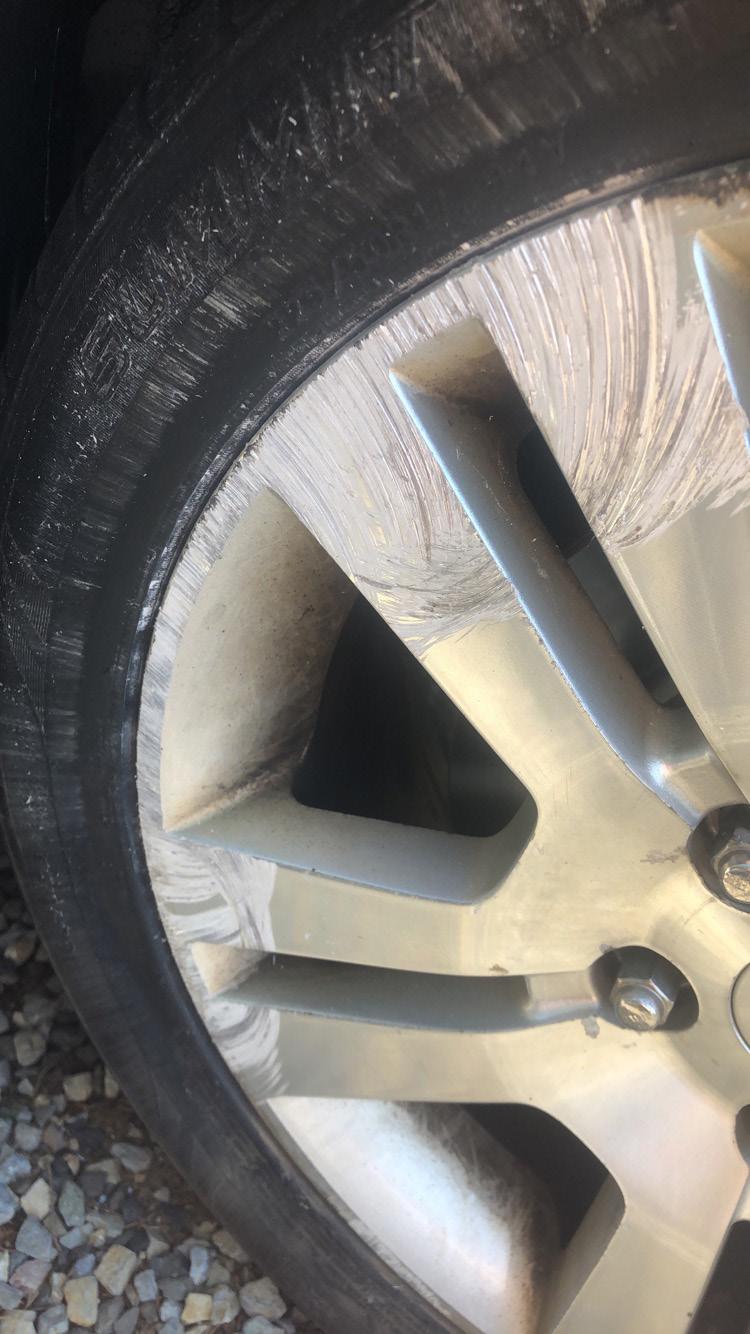
It is easy to remove minor scratches from car rims. You can usually solve this problem by polishing, which you can do yourself. For this purpose, you’ll use 200, 400, and 600-grit sandpaper and abrasive polishing paste. Let's take a closer look at how you can return your wheel rims to a great look and remove scratches and chips.
Before you begin to renew the discs and remove scratches, it is necessary to prepare your work area. Clear the area of dust and debris, and then (if possible) clean the walls and floor with water to remove any remaining dust. This way, dust and particles will not be deposited on the surface of the painted part of the car.

You will need the following tools and materials to perform the work yourself:
—• Water, detergent, and a brush to remove dirt from the rims
—• Sandpaper of different grit size to remove minor scratches and sanding
—• White spirit to degrease the rims
—• Finishing to fill cracks in the parts
—• Acrylic primer and spray paint
—• Clear varnish
—• Gloves, respirator, and safety glasses
We recommend using paint and primer from the same manufacturer to refinish rims and remove scratches. Also, if you have a mini washer available, you can clean the wheel rims with it.
You can take some measures to protect your wheels against picking up curb rash so you don’t have to deal with the consequences afterward. Sometimes this is unavoidable, but you can at least try to do your best.
—• Watch the curbs: Most of the time, the culprit is parallel parking. The single most effective way to keep those nice rims in good shape is to ensure that you can parallel park smoothly and confidently.
—• Clean carefully: Gentle soap and water and some elbow grease are just best for most cleaning.
—• Be suspicious of full-service carwashes. Far too many of them use acid-based cleaners on wheels. If you get a carwash, make sure you know what they're using on your wheels.











